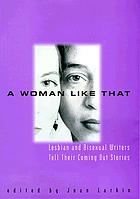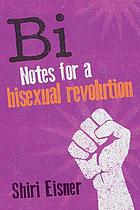While we were snowbound in Michigan, I had time to do quite a bit of reading. Two of the titles I read were
A Woman Like That: Lesbian and Bisexual Women Tell Their Coming Out Stories edited by Joan Larkin (Avon Books, 1999) and
Bi: Notes for a Bisexual Revolution by Shiri Eisner (Seal Press, 2013). Separated by nearly fifteen years, and written for very different purposes, yet grappling with similar subject matter, it was interesting to read them back to back.
A Woman Like That is -- at the subtitle implies -- an anthology of personal essays by queer women describing their experiences of coming-to-awareness of their sexual selves. "Coming out" is a term we typically use for the process by which we (non-straight) people make public the shape of our sexual desires. While mainstream narratives generally pin-point a singular event ("When did you come out?") what most of the essays in
A Woman Like That make clear -- and what most in the queer community already know -- is that
to come out is a verb, a process, and myriad. Reading these pieces challenged me to consider my own narrative of sexual awakening, and asked me to consider how I would organize it biographically. Does one begin with romantic/passionate friendships in childhood? With the acquired vocabulary that allows you to name yourself, or proscribes that ability (more on this below)? With a sexual debut? The first time you employed the word (bisexual lesbian dyke queer) to describe yourself to a (parent friend lover colleague medical professional) or on (on a form the internet) or in (an academic essay a job interview a survey response)?
The women in
A Woman Like That, whose essays are arranged roughly chronologically featuring stories from the 1950s to the 1990s, use a variety of these definitions of "coming out," often in combination. They describe childhood passions, first crushes, sexual initiations (good, not-so-good, violently non-consensual). They describe always knowing and coming to their realization later in life. They write a lot about the pain of living queer in an anti-gay world: of "reparative" therapies, of drugs, of physical abuse, of children taken away, of ruptured relationships, of fear and self-loathing. One of the things that startled me, in fact, and bogged me down in the reading, is how grim so many of these women's narratives were. Hanna and I joked, as I kept reading her excerpts, that it should have been titled "The Unhappy Dyke Book."

Still, as I said, the book made me think about the shape of my own story: the intense romantic friendships (same- and other-sexed); the inability to discern erotic from platonic attractions by gender in adolescence (I was told by multiple people "you'll know" ... what it turned out "I knew" was that gender was not a salient factor for me!); the internalized biphobia that caused me to de-legitimize my same-sex longings as invalid data; the sexual debut(s); the transition into a relationship, the describing of that relationship; the (mostly unruffled) reactions of people who found out I was dating a woman; the experience of getting married in a state where same-sex marriage is legally recognized.
Shiri Eisner, author of
Bi would probably frown upon my brand of bisexuality. For one thing, I'm an "assimilationist" bisexual, perpetuating my own erasure by playing nice with the mainstream LGBT (or "GGGG") movement, by often using language like "lesbian" to describe myself (even though I am, in fact, bi), and by marrying Hanna ("even if one particular marital arrangement doesn't include any form of direct violence, marriage still constitutes symbolic violence against women in and of itself").
Bi: Notes for a Bisexual Revolution challenges those of us with bisexual desires and identities to push for an end to bisexual invisibility, and to recognize the radical challenge the organization of our sexual desires pose for the sex, gender, and sexual hierarchy of what Eisner refers to as minority-world culture (more commonly known as Western culture).
In eight chapters, Eisner explores what bisexuality is, how
monosexism and biphobia work, bisexuality and the concept of "passing" and social privilege, and the intersection of bisexuality and feminism, trans* activism, racialization, and the mainstream gay movement. Overall, despite the fact that I suspect Eisner would take away my bisexuality card if she could, I thoroughly enjoyed this book. It's accessibly written, deeply researched (I'm already mining its bibliography for further reading), and thoughtfully inclusive of many different peoples and communities.
At times I felt like the apparatus of inclusivity was top-heavy and slightly arbitrary. For example, Eisner had a habit of identifying authors' nationalities which didn't always seem any more relevant to the meaning of their work than, say, their marital status, or whether they were parents. Still, I think probably over-articulating subjectivity is probably better than assuming objectivity or universal applicability. The other stylistic challenge of the "big tent" work Eisner is attempting to write is the way the text sometimes got bogged down in enumerations of what could
not be discussed, whom the next statements would
not be relevant for, and whose voices might be in danger of erasure. As with the identity-markers, these provisos sometimes felt like they were undercutting the relevance of the forthcoming passages and/or assuming a readership that would be unable to discern for itself about whom the text was speaking. While I fully appreciate what Eisner was trying to do, I found myself as a reader getting impatient with too much telling and not enough showing ("I
know that already! Get to the damn point!"). This is perhaps a personal limitation rather than an authorial flaw.
At the end of the day, I appreciate
Bi as a call to stand up for bisexuality as an actual-factual way of being sexual in the world, and one which is not an attempt to cover one's homosexuality or seek to gain heterosexual privilege. As an adolescent and young twentysomething, I needed someone like Eisner to come along and point out to me that my erotic interest in people with male parts and identities did
not trump my erotic interest in people with other parts and identities. For too long, I assumed that as a woman who was
capable of sexual attraction to men, my only social recourse was a heterosexual relationship.
(Because statistically speaking, in my hometown, what were the odds of finding a woman interested in me. Because lesbians would all hate and be suspicious of me. Because I was sexually inexperienced and too stupid to tell the difference between platonic and erotic interest; once I had sex with a man I'd suddenly realize what made that different from my same-sex romantic friendships. Because "everyone knows" that bisexuality is just a phase and that bisexual women are flakey, indecisive, and deceptive. Because no one believed me when I said I didn't know what orientation I was. Because the default sexual orientation is always straight and monosexual.)
While
A Woman Like That would likely only be of interest to people who like to think about the structure of coming-out narratives and about how the material experience of coming out has (and hasn't) changed since the mid-20th century, I'd argue that
Bi is absolutely essential reading for anyone who cares about keeping their fingers on the pulse of queer activism. As we look beyond, around, and through the mainstream gay rights issues that have preoccupied the most visible activists and activist organizations in recent years (i.e. as "gay" people become more accepted to the extent that they look and act like hetero, gender-normative folks), we
need to remain committed to gender, sex, and sexual diversity beyond the hetero/mono and male/female binaries that obsess Westerners and others across the globe.
Bi offers up a robust toolbox of concepts for doing so.













































